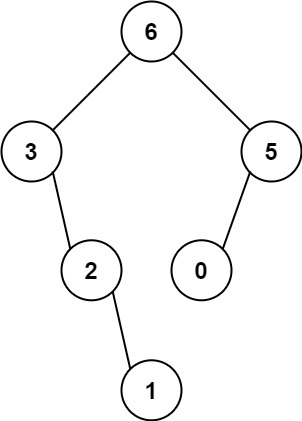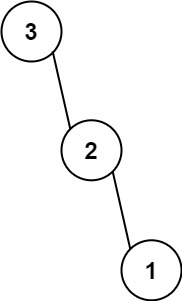Maximum Binary Tree
MediumYou are given an integer array nums with no duplicates. A maximum binary tree can be built recursively from nums using the following algorithm:
- Create a root node whose value is the maximum value in
nums. - Recursively build the left subtree on the subarray prefix to the left of the maximum value.
- Recursively build the right subtree on the subarray suffix to the right of the maximum value.
Return the maximum binary tree built from nums.
Example 1:

Input: nums = [3,2,1,6,0,5]
Output: [6,3,5,null,2,0,null,null,1]
Explanation: The recursive calls are as follow:
- The largest value in [3,2,1,6,0,5] is 6. Left prefix is [3,2,1] and right suffix is [0,5].
- The largest value in [3,2,1] is 3. Left prefix is [] and right suffix is [2,1].
- Empty array, so no child.
- The largest value in [2,1] is 2. Left prefix is [] and right suffix is [1].
- Empty array, so no child.
- Only one element, so child is a node with value 1.
- The largest value in [0,5] is 5. Left prefix is [0] and right suffix is [].
- Only one element, so child is a node with value 0.
- Empty array, so no child.
Example 2:

Input: nums = [3,2,1] Output: [3,null,2,null,1]
Constraints:
1 <= nums.length <= 10000 <= nums[i] <= 1000- All integers in
numsare unique.
Solution
Clarifying Questions
When you get asked this question in a real-life environment, it will often be ambiguous (especially at FAANG). Make sure to ask these questions in that case:
- Can the input array contain duplicate values?
- Can the array be empty or null?
- What is the range of values within the input array?
- If there are multiple possible maximum binary trees, is any one valid, or is there a specific criteria for choosing one?
- Is the input array guaranteed to contain unique values, or should I account for potential ambiguity in tree structure due to duplicates?
Brute Force Solution
Approach
The brute force approach to building the maximum binary tree involves exploring every possible tree structure we can create from the given values. We'll try every way to pick a root, then for each root, we'll try every way to build its left and right subtrees recursively.
Here's how the algorithm would work step-by-step:
- Consider each value in the list as a potential root of the entire tree.
- For each potential root, divide the remaining values into two groups: those smaller than the root (for the left subtree) and those larger than the root (for the right subtree). The order of the values is important.
- For each division into smaller and larger values, recursively apply the same process to construct all possible left subtrees and all possible right subtrees.
- Combine each possible left subtree with each possible right subtree and the chosen root to form a complete binary tree.
- Calculate a value for each complete tree based on the problem's criteria for a 'maximum' tree (e.g., sum of nodes, height).
- Compare the values of all the trees we've created and select the tree with the highest value as the 'maximum' binary tree.
Code Implementation
class TreeNode:
def __init__(self, value):
self.value = value
self.left = None
self.right = None
def find_maximum_binary_tree(values):
def construct_trees(current_values):
if not current_values:
return [None]
trees = []
for index, root_value in enumerate(current_values):
# Consider each value as a potential root
left_values = current_values[:index]
right_values = current_values[index + 1:]
possible_left_trees = construct_trees(left_values)
possible_right_trees = construct_trees(right_values)
# Generate all combinations of left and right subtrees for the current root
for left_tree in possible_left_trees:
for right_tree in possible_right_trees:
root_node = TreeNode(root_value)
root_node.left = left_tree
root_node.right = right_tree
trees.append(root_node)
return trees
all_trees = construct_trees(values)
# Determine the maximum tree based on a specific criteria (e.g., sum of nodes)
def calculate_tree_sum(root):
if not root:
return 0
return root.value + calculate_tree_sum(root.left) + calculate_tree_sum(root.right)
maximum_sum = float('-inf')
maximum_tree = None
for tree in all_trees:
current_sum = calculate_tree_sum(tree)
# Keep track of the tree that gives the largest sum.
if current_sum > maximum_sum:
maximum_sum = current_sum
maximum_tree = tree
return maximum_treeBig(O) Analysis
Optimal Solution
Approach
The core idea is to use recursion and divide-and-conquer. At each step, you find the largest value within a defined range of numbers. This value becomes the root of your tree, and the ranges to its left and right are then used to recursively build the left and right subtrees.
Here's how the algorithm would work step-by-step:
- Find the biggest number in the entire set of numbers.
- Make that biggest number the very top (root) of the tree.
- Now, look at the numbers to the left of the biggest number you just used. Treat those numbers as a smaller group and follow this entire process again to build the left part of the tree.
- Next, look at the numbers to the right of the biggest number. Do the same thing to build the right part of the tree.
- Keep repeating this process for each smaller group of numbers until you've used all the numbers to build the complete tree.
Code Implementation
class TreeNode:
def __init__(self, value=0, left=None, right=None):
self.value = value
self.left = left
self.right = right
def constructMaximumBinaryTree(numbers):
def buildTree(numbers, start_index, end_index):
# Base case: If the range is empty, return None
if start_index > end_index:
return None
# Find the index of the maximum value in the current range
max_index = start_index
for i in range(start_index + 1, end_index + 1):
if numbers[i] > numbers[max_index]:
max_index = i
# Create a new node with the maximum value as the root
root_node = TreeNode(numbers[max_index])
# Recursively build the left subtree.
# The left subtree will contain all values to the left of max value
root_node.left = buildTree(numbers, start_index, max_index - 1)
# Recursively build the right subtree.
# The right subtree will contain all values to the right of max value
root_node.right = buildTree(numbers, max_index + 1, end_index)
return root_node
return buildTree(numbers, 0, len(numbers) - 1)Big(O) Analysis
Edge Cases
| Case | How to Handle |
|---|---|
| Null or empty input array | Return null/empty tree, as there are no nodes to build the tree from. |
| Array with only one element | Create a single-node tree with that element as the root. |
| Array with all identical elements | The algorithm will still work correctly, constructing a tree, as it uses the index for breaking ties. |
| Array with elements in strictly increasing or decreasing order | The algorithm correctly builds a skewed tree (either left or right skewed) due to the recursive calls using the maximum value as the root. |
| Maximum size input array (e.g., limited by memory) | Ensure the recursion depth doesn't exceed stack limits for very large arrays, and consider an iterative solution if needed. |
| Input array contains negative numbers and/or zeros | The algorithm should handle negative numbers and zeros correctly as long as the comparison uses numerical order. |
| Integer overflow when handling very large numbers | Use long or appropriate data type if the numbers could exceed integer limits, considering language specific overflow protection. |
| Duplicate maximum values in different positions in the array | The algorithm chooses the first occurrence of the maximum value in the given range as the root, so the choice is deterministic. |